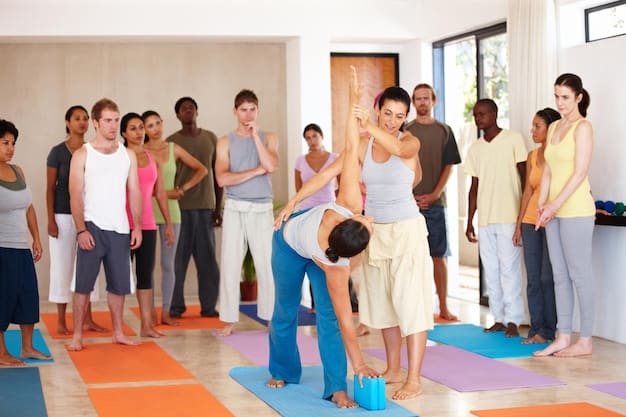Mindful Movement: Yoga and Tai Chi for Self-Care

Mindful movement, encompassing practices like yoga and tai chi, offers a potent pathway to enhanced self-care by fostering physical well-being, mental clarity, and emotional balance through gentle, focused exercises.
In today’s fast-paced world, prioritizing self-care is crucial for maintaining overall well-being. Incorporating mindful movement practices like yoga and tai chi into your daily routine can offer a powerful and accessible way to nurture your mind, body, and spirit. Let’s explore how mindful movement can elevate your self-care strategies.
Understanding Mindful Movement
Mindful movement is more than just physical exercise; it’s a holistic approach that integrates physical activity with mental awareness. By paying attention to your body’s sensations and movements, you can cultivate a deeper connection with yourself.
It’s a synergy where each movement becomes a meditation, improving both physical health and mental clarity.
The Essence of Mindful Movement
Mindful movement involves focusing on the present moment, observing your body’s sensations, and moving with intention. It encourages you to be fully present in your body, rather than getting lost in thoughts or distractions.
- Increased Body Awareness: Enhances your ability to perceive and understand your physical sensations and posture.
- Stress Reduction: Promotes relaxation by calming the nervous system and reducing cortisol levels.
- Improved Mental Clarity: Aids in clearing the mind, improving focus, and fostering a sense of inner peace.
This practice shifts the emphasis from achieving a physical goal to appreciating the journey of movement itself. This helps to promote inner peace and reduced stress.
Benefits of Yoga for Self-Care
Yoga is a traditional practice that combines physical postures, breathing techniques, and meditation. It offers a multitude of benefits that can significantly enhance your self-care routine.
From improved flexibility to reduced anxiety, yoga is a versatile practice for boosting your physical and mental well-being.

Physical Benefits of Yoga
Yoga can improve your flexibility, strength, and balance. Regular practice can also alleviate chronic pain and improve cardiovascular health. By stretching and strengthening your muscles, yoga helps to improve overall physical function and reduce the risk of injury.
These effects are significant for people of all ages and fitness levels.
Mental and Emotional Benefits of Yoga
Yoga is a potent stress reliever. The combination of physical postures and breathing exercises helps to calm the nervous system and reduce the production of stress hormones like cortisol. It can also promote feelings of relaxation, reduce anxiety, and improve mood.
- Stress Reduction: Lowers cortisol levels and promotes relaxation.
- Improved Mood: Enhances feelings of well-being and reduces symptoms of depression and anxiety.
- Increased Self-Awareness: Fosters a deeper connection with yourself, promoting self-acceptance and mindfulness.
Ultimately, the practice of yoga encourages both physical and mental wellness, creating a comprehensive self-care approach.
Exploring Tai Chi for Well-Being
Tai Chi, often described as “meditation in motion,” is a gentle and flowing exercise that originated in ancient China. It is known for its graceful movements and its ability to promote relaxation and well-being.
The slow, deliberate movements of Tai Chi make it a safe and effective exercise for people of all ages and abilities.
Physical Benefits of Tai Chi
Tai Chi improves balance, coordination, and flexibility. These benefits can reduce the risk of falls, especially among older adults. The gentle movements of Tai Chi also improve muscle strength, reduce joint pain, and enhance cardiovascular health.
- Improved Balance: Enhances stability and reduces the risk of falls.
- Increased Flexibility: Stretches and strengthens muscles and joints.
- Enhanced Cardiovascular Health: Provides a gentle cardiovascular workout, improving circulation and heart health.
Mental and Emotional Benefits of Tai Chi
Tai Chi fosters a sense of calm and relaxation. The slow, deliberate movements help to quiet the mind, reduce stress, and improve focus. Tai Chi also enhances mental clarity and improves emotional regulation.
Practicing Tai Chi regularly has been shown to reduce anxiety, improve sleep quality, and reduce symptoms of depression.
Combining Yoga and Tai Chi
Yoga and Tai Chi are both excellent practices for self-care. Combining them in your routine can yield even greater benefits. The blend of these practices can provide a more comprehensive approach to physical and mental well-being.
You can combine the high intensity of yoga with the soft movements of Tai Chi in order to maximize the impact of both.
Creating a Balanced Routine
Integrating both practices into your self-care routine can provide a comprehensive approach to wellness. You can alternate between yoga and Tai Chi sessions, or you can combine them into a single workout.
For example, you might start with a gentle yoga session to warm up your muscles and then transition into a Tai Chi routine to promote relaxation and balance.

Synergistic Benefits
Combining yoga and Tai Chi can enhance the benefits of each practice. Yoga can improve your flexibility and strength, while Tai Chi can enhance your balance and coordination. Together, they can improve your overall physical and mental well-being.
The meditative aspects of Tai Chi can deepen your yoga practice, while the physical challenges of yoga can improve your Tai Chi form. Such synergistic action can benefit both physical and mental wellness.
Practical Tips for Incorporating Mindful Movement
Incorporating mindful movement into your daily routine doesn’t require a complete overhaul of your lifestyle. Even small changes can make a big difference in your overall well-being. The key is to start slowly and gradually increase the amount of time you dedicate to these practices.
If time constraints are a concern, even 10 to 15 minutes a day can yield positive results.
Starting Small
Begin with short sessions of yoga or Tai Chi. Even 10-15 minutes a day can provide significant benefits. You can gradually increase the duration and intensity of your sessions as you become more comfortable with the practices.
Finding a Quiet Space
Create a peaceful and clutter-free environment where you can practice without distractions. This will help you focus on your movements and sensations. The space should be conducive to relaxation.
- Designated Area: Set up a specific area in your home for your practice.
- Minimize Distractions: Turn off your phone and other electronic devices.
- Create a Calming Atmosphere: Include elements like soft lighting, candles, or relaxing music.
Staying Consistent
Consistency is key to experiencing the full benefits of mindful movement. Try to establish a regular schedule for your yoga or Tai Chi practice. Even if you can only practice for a few minutes each day, doing so consistently will make a difference.
Whether you practice in the morning, during your lunch break, or in the evening, find a time that works best for you and stick to it.
Overcoming Challenges
When starting with mindful movement, you may encounter challenges such as lack of time, physical limitations, or difficulty focusing. Here are some strategies to help you overcome these obstacles.
Don’t be discouraged if you face hurdles; persistence and adaptation can lead to lasting success.
Time Constraints
If you struggle to find time for a full yoga or Tai Chi session, micro-practices can be helpful. Incorporate short bursts of mindful movement throughout the day, such as stretching at your desk or practicing a few Tai Chi movements during your lunch break.
These small moments of mindfulness can add up and provide significant benefits.
Physical Limitations
If you have physical limitations, modify the poses or movements to suit your abilities. Use props like cushions or blankets to make poses more comfortable. Consider working with a qualified instructor who can provide personalized guidance.
Staying Focused
If you find it hard to focus during your practice, remember that it’s normal for your mind to wander. When you notice your attention drifting, gently redirect it back to your breath or your movements. With practice, your ability to focus will improve.
Mindful movement is a skill that improves over time. It requires patience and practice.
| Key Point | Brief Description |
|---|---|
| 🧘♀️ Yoga Benefits | Enhances flexibility, reduces stress, improves mood and increases body awareness. |
| 🌿 Tai Chi Advantages | Improves balance and coordination, reduces risk of falls, enhances mental clarity and fosters relaxation. |
| ⏱️ Starting Small | Begin with 10-15 minute sessions daily, gradually increasing duration as comfort increase. |
| 🧘♂️ Overcoming Obstacles | Incorporate micro-practices, modify poses, and redirect focus when mind wanders. |
Frequently Asked Questions
▼
Mindful movement is a practice that integrates physical activity with focused attention on the present moment. It involves being aware of your body’s sensations, movements, and overall experience during exercise, promoting a deeper connection between mind and body.
▼
The ideal frequency depends on your goals and schedule. Aim for at least 2-3 times a week to experience significant benefits. Even short, daily sessions of 15-20 minutes can be effective if you’re consistent over time.
▼
Yes, both yoga and tai chi can be modified to accommodate various physical limitations. It’s recommended to consult with a qualified instructor who can provide personalized modifications and ensure you’re practicing safely and effectively.
▼
Mindful movement can significantly improve mental health by reducing stress, decreasing anxiety, enhancing mood, and promoting emotional regulation. It also encourages mindfulness, which helps to center your thoughts and increase self-awareness.
▼
To stay motivated, set realistic goals, track your progress, and celebrate your achievements. Find a practice style you enjoy, whether it’s a specific type of yoga or tai chi, and consider joining a class or online community for support and accountability.
Conclusion
Incorporating mindful movement through yoga and tai chi into your self-care routine offers a transformative path to holistic well-being. By engaging in these practices, you not only enhance your physical health but also cultivate mental clarity and emotional balance. Start integrating these techniques into your daily life, and appreciate the lasting impact of mindful movement.





